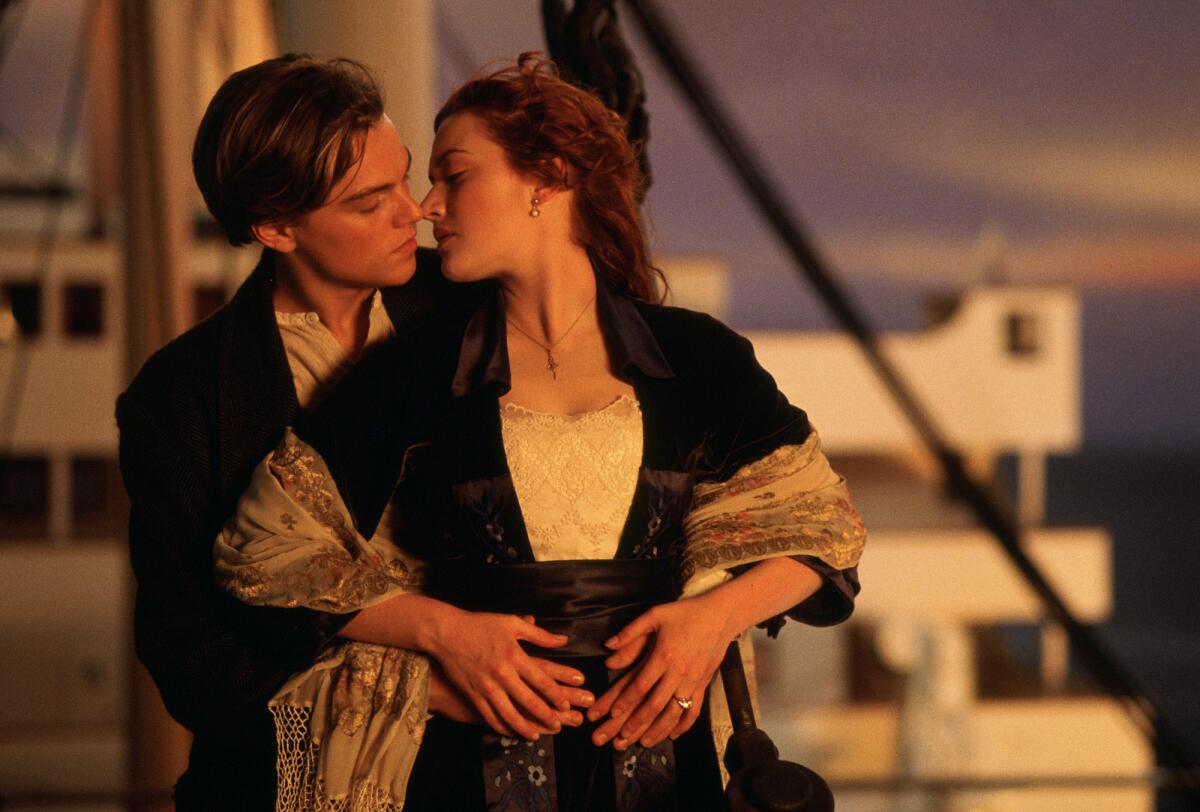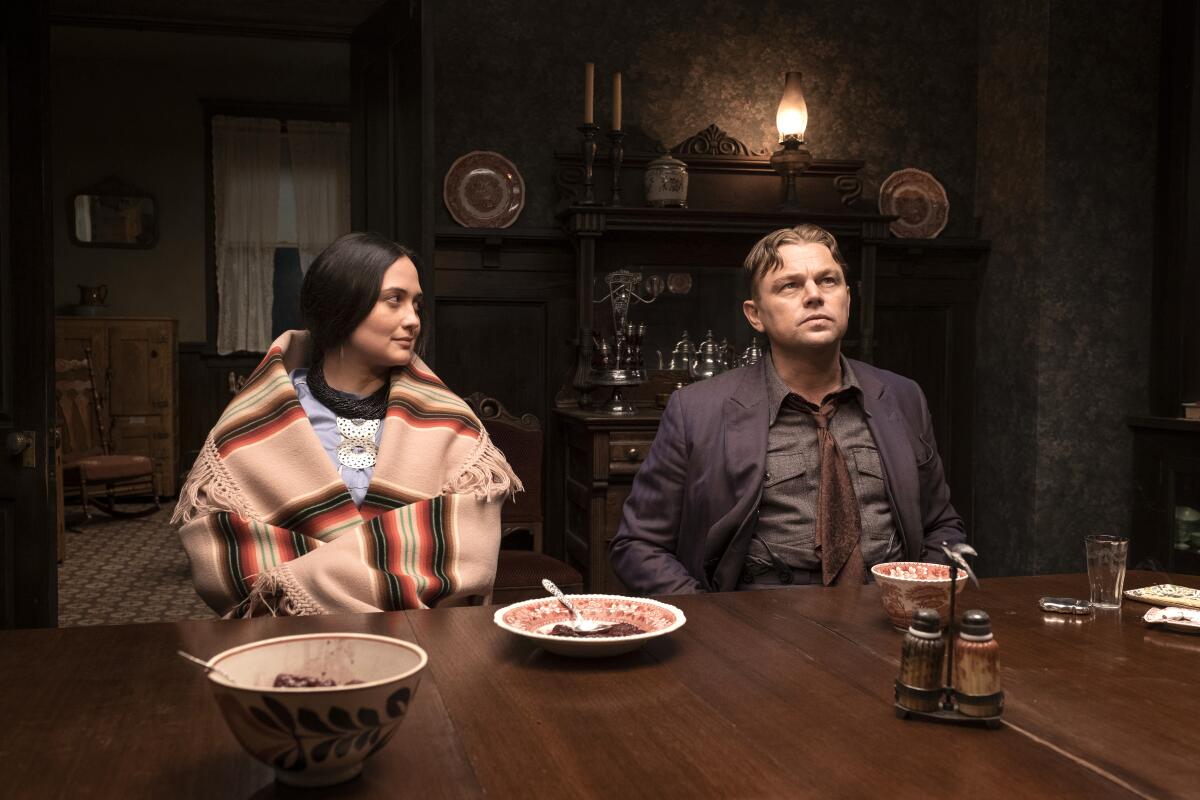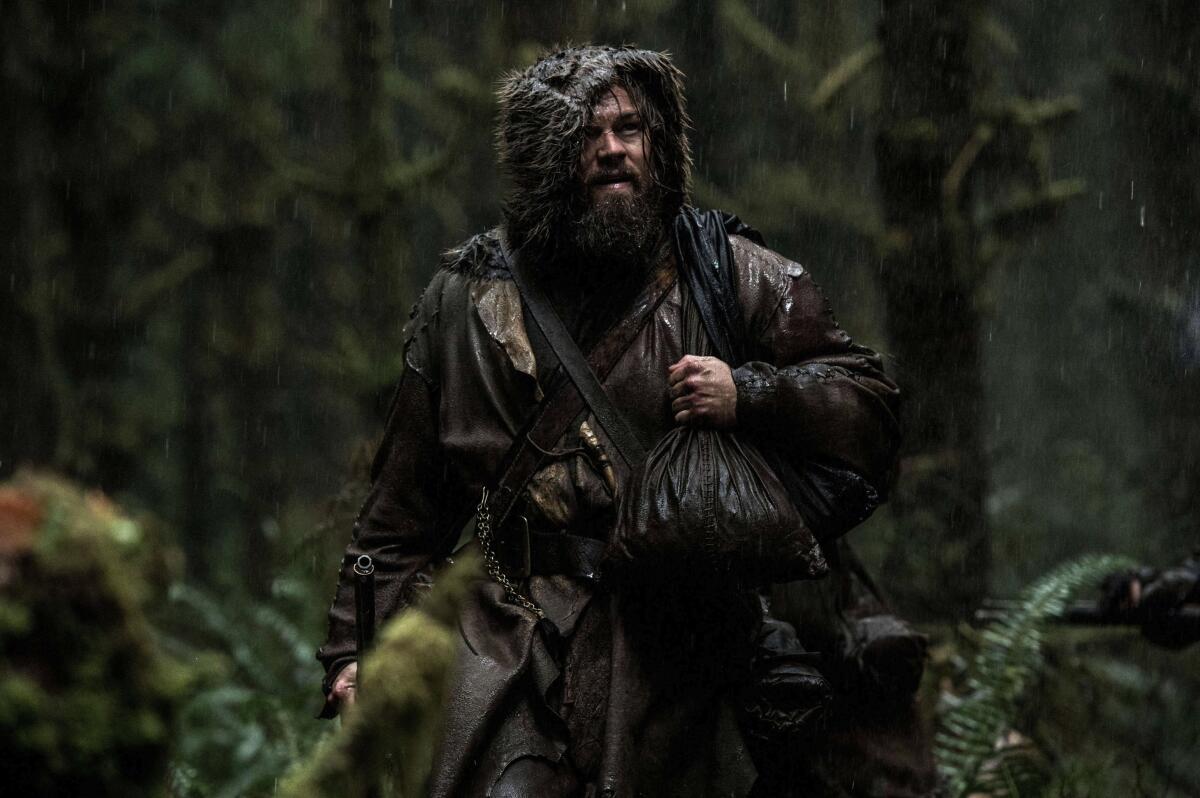‘Titanic’ made Leonardo DiCaprio a Hollywood heartthrob. He’s been avoiding it ever since

- Share via
“Leonardo DiCaprio is the most riveting and sought-after new actor in Hollywood. From the moment he appeared on the big screen, the camera loved him. With his piercing blue-green eyes and his shock of blond hair, Leonardo is breaking hearts and box-office records around the globe.” — from “Leonardo DiCaprio, Modern-Day Romeo” by Grace Catalano
To be alive in 1998 was to be acutely aware that a man named Leonardo DiCaprio roamed the Earth — and that seemingly wherever he went, screaming girls and clamoring paparazzi were sure to follow.
In the 12 months that followed the release of “Titanic” in December 1997, the world was gripped by a case of celebrity fervor that rivaled the heyday of the Beatles and — with all due respect to Harry Styles and Timothée Chalamet — has not been replicated since.
“Titanic” reigned at the top of the box office for 15 weeks, becoming the highest-grossing film of all time, a title it would hold for 12 years. The success of the movie, the subject of much skeptical pre-release coverage about its then unprecedented $200-million budget, was anything but guaranteed. It was fueled largely by the passion of young women and teenage girls who swooned over DiCaprio’s portrayal of Jack Dawson, the vagabond artist who stole the heart of rich girl Rose DeWitt Bukater (Kate Winslet), then saved her life by sacrificing himself to the icy depths of the North Atlantic (even though we all know there was room for two people on that door).
Leonardo DiCaprio, Robert De Niro and Lily Gladstone star in Martin Scorsese’s ambitious adaptation of David Grann’s book about marriage and murder in 1920s Osage country.
These young admirers, many of whom had fallen for DiCaprio’s sensitive performances in “What’s Eating Gilbert Grape,” “This Boy’s Life” and “William Shakespeare’s Romeo + Juliet,” went to see the movie half a dozen times or more. Their curiosity turned quickie, unauthorized biographies like “Leonardo DiCaprio: Modern-Day Romeo” into bestsellers and compelled them to fire up their modems and head to GeoCities to make rudimentary websites that functioned like virtual bedroom walls.
The media couldn’t get enough of Leomania, publishing breathless accounts of his romantic conquests and chronicling the late-night exploits of the actor’s infamous posse, a tight-knit circle of friends that included Tobey Maguire and Kevin Connolly. DiCaprio was so ubiquitous that the Taliban reportedly arrested barbers for giving men haircuts modeled after Jack Dawson’s floppy ’do.
“Titanic” would go on to win 11 Oscars, including best picture, though DiCaprio was not even nominated — a snub that inspired fans to flood the Academy of Motion Picture Arts and Sciences with angry phone calls. His exclusion looks even more egregious with the benefit of hindsight. (The category that year was dominated by veterans like Dustin Hoffman and Jack Nicholson, with the “cute young guy” slot going to Matt Damon for “Good Will Hunting.”) It was clear that academy voters didn’t take DiCaprio seriously when he was in matinee idol mode — and that his “limp, lovesick” teenage fans were not considered trustworthy arbiters of taste. Even DiCaprio was, at times, openly disdainful of his adolescent admirers; members of his entourage were known to dump water on fans loitering outside his apartment building.

DiCaprio, who skipped the Oscars that year, could barely mask his ambivalence about “Titanic” and the way it launched him from misfit roles into leading-man territory. “After the whole experience, I know it’s really not my cup of tea,” he told Vanity Fair.
The period after “Titanic” “was a very empty existence,” DiCaprio said in a New York Times profile — a rare solo sit-down for the actor — in 2002, as he was staging what was then viewed as a “comeback.” “I’d get headaches from dealing with pure unadulterated garbage. But you can’t help it. It becomes who you are. You’re suddenly defined in the media as a cutie-pie.”
DiCaprio has spent the last quarter century doing everything in his power to make audiences forget he could ever be considered a “cutie-pie” — or anything less than a Very Serious Actor.
His transformation culminates this week with the release of “Killers of the Flower Moon,” directed by his longtime collaborator Martin Scorsese. Based on David Grann’s engrossing nonfiction bestseller, the epic dramatizes the Osage Reign of Terror, a period in the 1920s when dozens of oil-rich Osage people were systematically murdered by white people attempting to gain control of their fortune — a spree of greed-fueled, racist violence that has received scant attention in the history books, or from Hollywood.
Mexico’s Rodrigo Prieto has developed close working relationships with Martin Scorsese, Greta Gerwig and Taylor Swift. And he’s directing his own movie as well.
With tobacco-stained teeth and a protruding underbite reminiscent of Marlon Brando in “The Godfather,” DiCaprio stars as Ernest Burkart, a dim-witted World War I veteran roped into a sinister plot devised by his uncle, William “King” Hale (Robert De Niro), a self-proclaimed friend of the Osage who, it soon becomes clear, is anything but. At Hale’s behest, Ernest marries an Osage woman named Mollie Kyle (a mesmerizing Lily Gladstone), whose relatives begin to die off, one by one, under mysterious circumstances. Eventually, Tom White (Jesse Plemons), an agent with the newly formed Bureau of Investigation, rolls into town to find out who is behind the crimes — something the audience knows from the opening minutes of the film.
Though DiCaprio plays him as more of a tragic rube than a cold-blooded killer, Ernest is, arguably, his most villainous character to date — Jack Dawson’s evil, boneheaded twin — and easily his most despicable since Calvin Candie, the sadistic plantation owner in “Django Unchained.” Let’s put it this way: if Ernest had been on the Titanic, he would have taken the whole door for himself. And probably pushed Rose into the ocean while he was at it.
DiCaprio was originally attached to star as White, who is a much more significant figure in Grann’s book. Early drafts of the script by Scorsese and Eric Roth focused on the investigation into the murders, but several years into the development process, the project was drastically overhauled, reportedly at the insistence of DiCaprio, who was recast as Ernest. Instead of a white savior narrative about valiant law enforcement officials cracking the case, “Killers of the Flower Moon” now centers on the twisted relationship between Mollie and Ernest.
While the impulse to re-frame the story and foreground the Osage perspective is understandable, even laudable, the end result is a movie that spends more than three hours following two white men as they enact a slow-rolling genocide of their own extended family. The pickings may have been slim in 1920s Oklahoma, but it’s also difficult to comprehend why Mollie, who is stoic but shrewd, would fall for someone as transparently sleazy as Ernest.

With a running time of three hours and 26 minutes (12 minutes longer than “Titanic”) and a reported budget of $200 million, “Killers of the Flower Moon” is exactly the kind of Big, Important Movie that DiCaprio has been making, almost exclusively, since he became the king of the world. He has not starred in a feature film under two hours since “The Beach” in 2000, which clocked in at one hour and 59 minutes.
After that picture, a critical disappointment that did middling box office, he took several years off, before returning to film by pairing with two of our greatest living auteurs: Steven Spielberg, whose breezy “Catch Me if You Can” starred DiCaprio as a charming con artist, and Scorsese, whose gritty 19th century epic about American identity, “Gangs of New York,” began a long and fruitful collaboration.
Since then, DiCaprio has worked almost exclusively with well-established (read: male) directors — Scorsese, Quentin Tarantino, Alejandro González Iñárritu, Christopher Nolan — on films with obvious awards aspirations. He’s donned an array of regrettable facial hair, old-age makeup and greasy wigs to transform into vile plantation owners, shameless financial criminals, rumpled astronomy professors, washed-up actors and legendary real-world paranoiacs. He is not so much Hollywood’s biggest movie star as its best-paid character actor.
DiCaprio, who turns 50 next year, has generally done everything he can to dim his still boyish good looks, except in “The Great Gatsby,” an adaptation of perhaps the most celebrated American novel of the 20th century that he was initially reluctant to join because he remembered it as a “ traditional love story.” In 2016, he finally won an Oscar, after four previous nominations, for his performance as a vengeance-hungry frontiersman in “The Revenant.” His characters often die, but since “Titanic,” they rarely do so for love.

DiCaprio has taken physical risks, famously eating raw bison liver and filming in the freezing cold for months on end in “The Revenant,” for instance, but creatively he has taken a safer approach. (He has also taken fewer at-bats, only appearing in four feature films since 2014.) And though he hasn’t made an abject stinker in decades, the rebelliousness and messy experimentation that marked his pre-”Titanic” films, like “The Basketball Diaries” or “Total Eclipse,” have long since given way to the caution of someone afraid of not being taken seriously. (“Total Eclipse,” released in 1995 and centering on the relationship between French poets Arthur Rimbaud and Paul Verlaine, is also the last time DiCaprio starred in a narrative feature directed by a woman.)
He has also strictly guarded his privacy, rarely granting extensive solo interviews or making routine chit-chat on late night TV, and he has assiduously cultivated his image as a serious climate change activist by producing documentaries and launching an environmental foundation.
In the early years of his fame, DiCaprio was candid with journalists, coming off as a charming prankster and precocious cut-up. He spoke of wanting to get married and have children, even telling Interview’s Ingrid Sischy that Pauly Shore taught him all about sex and girls (in retrospect, a major red flag). Nowadays, when he does do press, he tends to rehash the same colorful anecdotes that delight talk show viewers but ultimately reveal almost nothing about his life, like the time he was flying to Russia and the engine on the plane failed.
The internet has filled the resulting void by caricaturing DiCaprio — who wears an average bro uniform of T-shirts, cargo shorts, baseball caps and sunglasses when off-duty — as an aging Lothario who dumps his girlfriends the minute they turn 25. When he (or, more likely, his social media team) posts earnestly on Instagram about endangered frogs, the comments inevitably turn to jokes about how old the frog is.
The “accent nerd” went to extraordinary lengths to sound like a Pennsylvania native for HBO’s “Mare of Easttown.” Here’s how she did it.
The irony is that DiCaprio’s young female fans appreciated his talents before many others in Hollywood. They knew he was way better than he needed to be as a homeless teenager in the final season of “Growing Pains,” where, in a textbook example of “Cousin Oliver Syndrome,” he was brought in to revive a flagging sitcom. They felt his anguish in “This Boy’s Life,” his first movie with Robert De Niro, who was so impressed with his young co-star that he called up his old pal Scorsese to tell him about it. And they propelled “William Shakespeare’s Romeo + Juliet,” Baz Luhrmann’s MTV-ified take on the classic tragedy, to become a surprise box office hit. For teenage girls who considered themselves too edgy for Jonathan Taylor Thomas, DiCaprio represented a different kind of heartthrob, and an heir apparent to River Phoenix, whom DiCaprio also idolized. Even his name — Leonardo DiCaprio — seemed romantic.
It’s instructive to look at how Winslet, his co-star in “Titanic” and, later, “Revolutionary Road,” has approached her post-”Titanic” career. Though she has also won an Oscar and cemented her status as one of the finest actors of her generation, she has experimented wildly. She’s played prickly and unlikable characters, starred in cozy romantic comedies, big-budget thrillers and queer period pieces. She’s worked with legendary directors and up-and-comers and has even — gasp! — done TV. Several times. This may be why the teenage girls who once memorized every piece of Leo trivia like it was sacred scripture — Did you know an agent once tried to get him to change his name to Lenny Williams? — are now middle-age women who have long since shut down their fan sites and eagerly await a possible second season of “Mare of Easttown.”
It may have been a cash grab, but the very existence of “Leonardo DiCaprio, Modern-Day Romeo” acknowledged, as perhaps even DiCaprio himself has not, that the actor’s female fans were central to making him the sort of hero James Cameron or Martin Scorsese could hang a film on. And though he’s since run away from the persona they loved, there would be no Leomania, or Leonardo DiCaprio as we know him, if those fans hadn’t supported him first.
Not that young women alive in 2023 are terribly bothered about it. According to most projections, they’ll be too busy keeping another star-driven epic atop the box office this weekend: “Taylor Swift: The Eras Tour.”
Research librarian Scott Wilson contributed to this article.
More to Read
Only good movies
Get the Indie Focus newsletter, Mark Olsen's weekly guide to the world of cinema.
You may occasionally receive promotional content from the Los Angeles Times.









